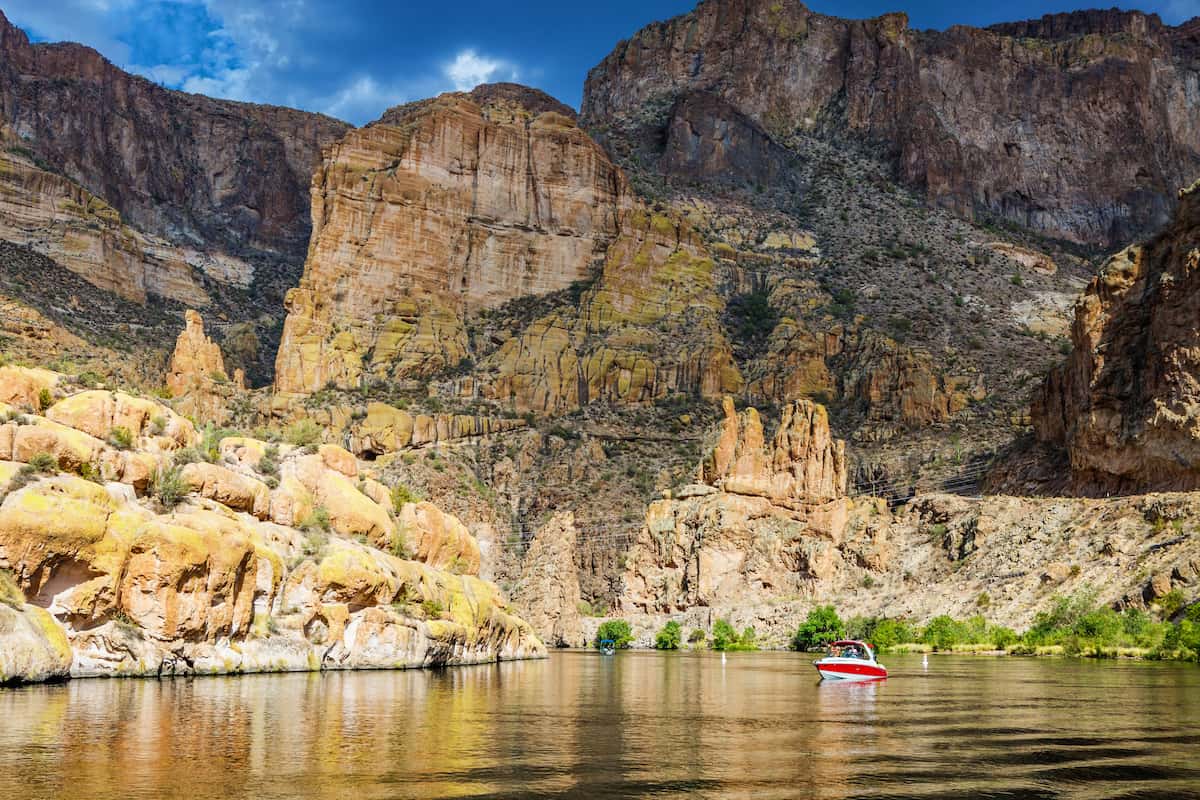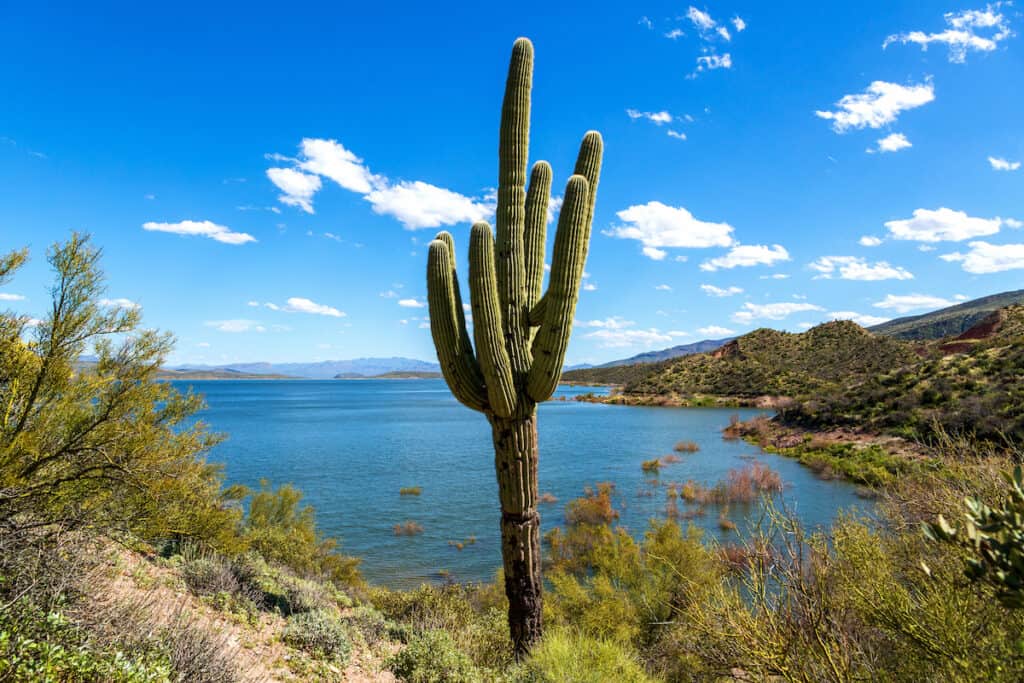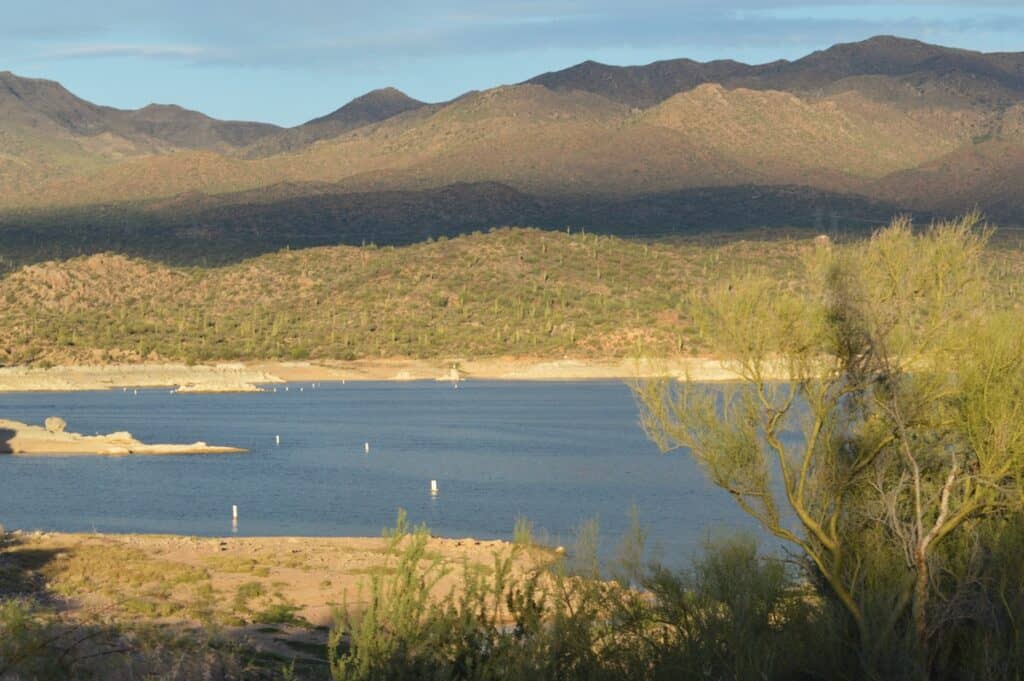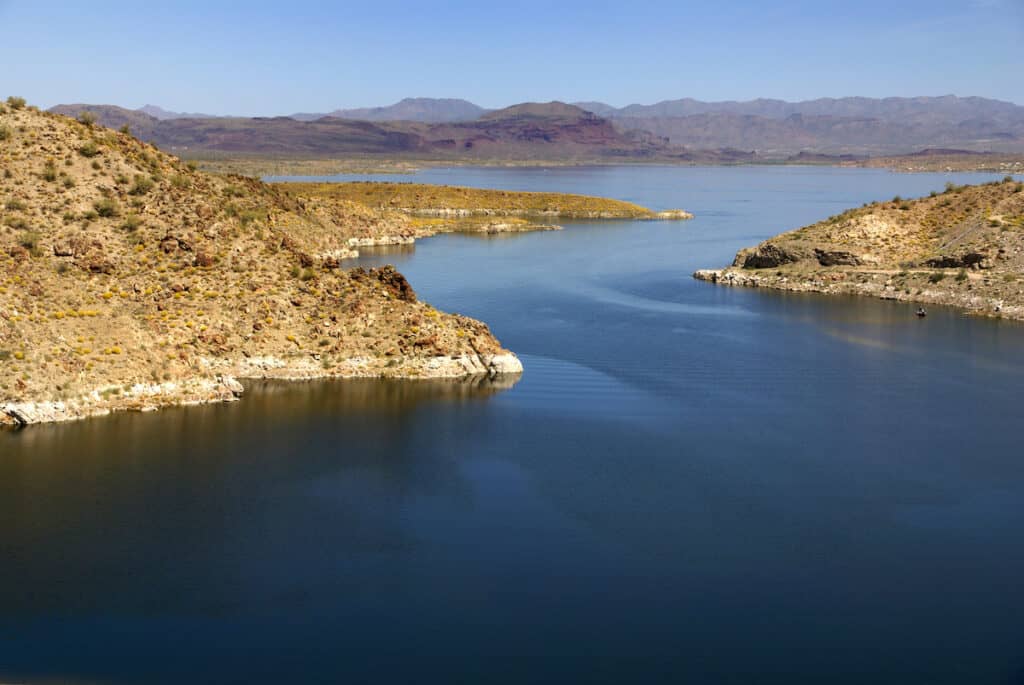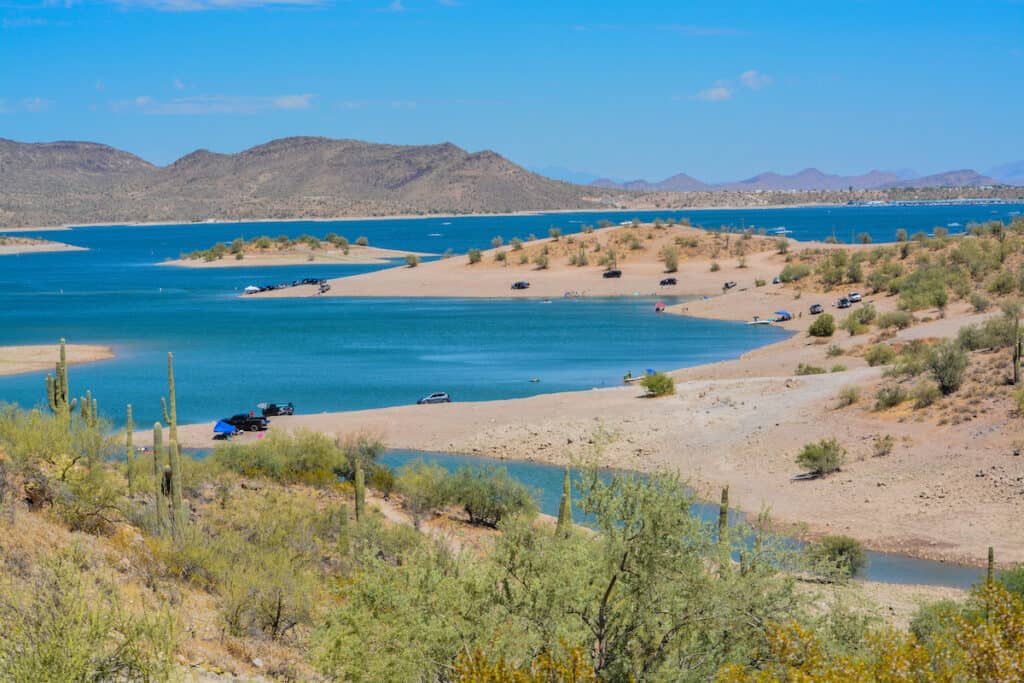Arizona offers year-round fishing opportunities for crappie.
These scrappy panfish put up a hard fight on light tackle, and they are some of the tastiest fish in freshwater. That’s what we call a win-win.
Crappie were first introduced to Arizona in 1903, and they’ve come to thrive in the state’s large desert reservoirs. Many of these man-made lakes offer everything a crappie could want: brushy cover, varied depths, and lots of small minnows to feast on.
Both species of crappie—black crappie and white crappie—can be caught in Arizona, but black crappie are far more common. They are adaptable to a wide range of habitats, but prefer clear to lightly stained water and tend to favor woody structure like standing timber and submerged brush piles.
The best seasons to catch crappie in Arizona are early spring and late fall, but they can be caught any time of year.
Winter provides some highly underrated crappie fishing opportunities, and you can catch them in summer too if you’re willing to search deeper waters.
Crappie are oval-shaped panfish with a noticeably flattened or compressed body shape. Compared to their sunfish cousins, crappie have larger mouths for their body size, and their large eyes give them keen vision for scoping out small minnows and other prey.
Keeper crappie commonly measure 10 to 14 inches, but they are capable of getting much bigger and weighing upwards of 3 pounds. They travel in schools, so if you catch one, it’s likely that there are many more nearby.
Arizona Crappie Fishing Tips
Crappie prefer water temperatures between 65 and 72 degrees, and they will seek out water that is within their comfort zone. In most Arizona lakes, you can find crappies around brushy and woody structure in 15 to 25 feet of water throughout much of the year.
That being said, they’ll go deeper during the heat of summer or the cold of winter to find water more to their liking.
Crappies spawn in springtime when waters warm up to the low 60s. In most Arizona lakes, that happens around the end of February or the beginning of March.
This is the time of year when crappies will be in the shallowest water, often less than 10 feet. They also will often be found in the biggest concentrations and will be extra aggressive, making this the time of year they are easiest to catch.
Live minnows are arguably the most effective crappie bait. A fathead or other type live minnow suspended under a bobber excels when crappies are in relatively shallow water, or are feeding within a few feet of the surface.
Generally speaking, it’s always wise to double-check the regulations for the area you plan to fish before using live fish or other aquatic animals such as crayfish for bait. Restrictions may include not just which waters they are legal but also types of minnows that a permitted to avoid introducing invasive species.
If you don’t want to fish with live bait (which can add a bit of fuss to your day), crappie also respond well to artificial lures.
Generally, anything that mimics a small minnow can tempt crappies. That list includes spinners, spoons and miniature crankbaits.
However, overall small jigs are the lure of choice. These lures include marabou crappie jigs and a huge array of soft plastic jigs.
Just about any soft plastic body that can fit on a 1/16 or 1/32-oz jighead has potential. Tubes and grubs are standard-issue among crappie fanatics, but lure makers have gotten pretty creative with crappie baits, so feel free to do the same.
White and chartreuse are often the most effective colors, but darker and more natural tones are preferable at times. Conditions including water clarity and light intensity can influence the hot lure color.
An ultralight spinning combo spooled with 4-pound test line is ideal for crappie fishing. A lot of crappie anglers prefer fluorocarbon line for its low visibility and abrasion resistance, as well as its higher density compared to monofilament.
Ultralight tackle is essential for getting a good cast with tiny jigs and baits. Look for a sensitive rod with a flexible tip, yet enough backbone for a decent hookset. Don’t set the hook too solid, as there’s a reason one of their nicknames is “paper mouths.”
Trolling can be the most effective way to find crappies, especially when fishing an unfamiliar lake. Look for submerged trees and brush piles on your depth finder, and scan the surface of the lake visually for exposed cover.
When you’ve found a likely spot, troll slowly with jigs or a tiny crankbait at a depth just above the tips of submerged brush or branches, or just outside the edges of visible structure, until you start getting bites.
Once you’ve found fish, it pays to slow down and start jigging or making casts with bait.
In large reservoirs like the very best crappie spots found in Arizona, it’s often a good idea to mark a productive spot, either on your electronics or with a buoy, in order to keep track of where the fish are.
In spring and fall, when conditions are relatively stable and crappies are actively feeding, an aggressive presentation is often most effective. In winter, try slowing down a bit.
Crappies tend to be a bit lethargic in chilly water but will gently suck in a meal that lands in front of them, so pay attention to very subtle bites that may just feel like a bit more weight.
Of course, one of the great things about fishing for crappies in these Arizona lakes is that it seldom gets truly cold.
You’ll find even more crappie-catching tips in our simple fishing guide.
Fabulous Four Crappie Spots
Here are the very best crappie lakes in Arizona.
Roosevelt Lake
Theodore Roosevelt Lake (most folks just call it Roosevelt Lake) is a vast man-made reservoir along the Salt River. Located about 80 miles northeast of Phoenix, it’s the largest lake that lies entirely within the state of Arizona.
With a surface area of more than 21,000 acres, there’s a lot of water to cover, and Lake Roosevelt’s massive size can be intimidating. Fortunately, there are more than enough slab crappies here to go around.
November is a favorite month among local crappie anglers on Lake Roosevelt due to its stable weather patterns, but there are often solid crappie bites throughout winter and into early spring.
For the most part, anglers target brush and timber anywhere from 15 to 25 feet of water, though the fish may be as far down as 45 feet in the dead of winter.
You’ll start to see crappies move toward shallow coves and creek mouths around March as they prepare to spawn.
Any time crappies congregate around submerged brush and timber, vertical jigging is an effective tactic. A wide range of soft plastic jigs can do the trick, including curlytails and tube jigs.
Trolling is usually a more effective tactic in summer as schools of crappie disperse and become harder to find.
Some of the best crappie fishing is concentrated toward the east end of Lake Roosevelt, around the Salt River Inlet. Try jigging around Cougar Point, where there’s a lot of woody cover at various depths.
Methodist Cove and Chubb Bay are a couple of other excellent crappie areas, with loads of submerged brush, including fish-attracting structures that have been placed there by the Arizona Game & Fish Department.
Lake Roosevelt has a mostly undeveloped shoreline with plenty of access overall, almost endlessly so for boaters.
Shore access is tougher in many places due to steep banks, but the U.S. Forest Service operates several boat ramps, shore fishing sites and campgrounds around the lake within Tonto National Forest.
More: Roosevelt Lake Fishing
Apache Lake
Much like Lake Roosevelt, Apache Lake is a man-made Salt River Reservoir. But at a little over 2,500 acres, it’s a much smaller lake, and one that tends to attract fewer tourists and pleasure boaters.
That’s good news for crappie anglers who prefer to fish in relative solitude. Apache Lake has a reputation for kicking out some of the biggest crappies in Arizona, and plenty of them.
Apache Lake has an abundance of steep points, rock piles, bluff walls and river channel drop-offs.
Depths around 20 feet are loaded with submerged trees and brush. Often the best tactic is to locate a tree or brush pile and fish it thoroughly before moving on to another.
The stretch of shoreline from Saguaro Point to Horsetail Bay is often productive, with plenty of points, drop-offs, brush and rocky cover. Other prime crappie spots include Sam’s Straight, Haystack Point and the area around Alder Creek and Amethyst Cove.
PowerBait grubs are popular on Apache Lake, especially in chartreuse and pearl white colors. When you’re in search mode, try trolling small shad-imitating crankbaits over the tops of trees and brush.
Like a lot of Arizona lakes, crappie fishing here is at its best in late fall and early spring. Get to the water early, and it’s entirely possible to catch your limit by 10 a.m.
On sunny days, crappies often retreat to the shade of the river channel toward midday, but they are likely to haunt near-shore brush when it’s shady.
The Apache Marina and Resort and at Burnt Corral areas offer some of the best shore fishing on Apache Lake. There are a number of lakeside trails and dirt roads in the area where you can pull off and hike along the shore.
Bartlett Lake
Bartlett Lake has had its ups and downs over the years. I mean that quite literally—maintenance on the dam a few years back resulted in some major swings in water level and clarity.
Crappie fishing, which tends to be cyclical, has had its ups and downs as well.
Still, Bartlett always deserves to be part of the conversation when it comes to great Arizona crappie lakes. The crappie fishery has shown some upward momentum in recent years, and the Arizona GFD stocked over 14,000 sub-catchable black crappies in 2021.
The department has also placed thousands of brush piles, Christmas trees and other fish attracting structures around the lake, providing ample habitat for crappie. Try dropping jigs tipped with live minnows around brush and trees.
A Verde River reservoir spanning just over 2,000 acres, Bartlett Lake is surrounded by beautiful mountain scenery. It’s a long, narrow lake that stretches about 12 miles end-to-end.
Late fall is a great time to be on Bartlett Lake chasing slabs. The water temperatures drop significantly from October into November, and crappies emerge from their deep summer haunts and can often be caught around brush piles and trees in 10 to 15 feet of water.
When you arrive at the lake, the Bartlett Lake Marina is a great place to start. In addition to being one of the lake’s better boat ramps, the marina offers quick access to prime crappie water.
Crappies commonly hang out around the mouth of the cove near the marina. It’s a great area for kayak fishing.
The area around the dam and power lines is often productive as well.
Far up at the northern end of the lake, the promisingly-named Bass Flats and Crappie Cove often harbor fish. The water up at this end tends to be a bit muddier, so try baits with a little extra flash.
Besides the bass and crappie those names suggest, Bartlett Lake also is among the best catfish fishing lakes in Arizona.
More: Bartlett Lake Fishing
Alamo Lake
A 3,500-acre reservoir in the Sonoran Desert, Alamo Lake is consistently one of the best fishing spots in Western Arizona. Rocky banks and rugged scenery dominate the shoreline, but the lake itself is a haven for bass, crappie and catfish.
As tends to be the case with crappie fishing in Arizona, zeroing in on woody cover is often key here.
The lake has a ton of flooded brush and standing timber, much of it extending well above the waterline. This makes crappie habitat easy to spot, but it also warrants extreme caution for boaters.
All the exposed timber tends to keep pleasure boats and personal watercraft at bay, which is great news for anglers. There’s a stand of vertical timber smack-dab in the middle of the lake, which is a favorite fishing spot.
Threadfin shad are the main forage fish in Alamo Lake, so any small lure with a shad-like profile can tempt crappies.
That said, all the usual jigs and other small lures will work here. The water tends to be moderately stained, so white jigs and anything with a bit of flash can do the trick.
Water levels are the wild card at Alamo Lake. It’s been low in recent years, which could hinder crappie spawning and impact numbers in the long run. Time will tell, but for now, the fishery appears to be in good shape.
Late winter and early spring tend to see the highest water levels, and are also the best times to be out on Alamo Lake chasing crappies.
In good years, there are a lot of 15-plus-inch crappies here, and many anglers troll in 15 to 30 feet of water looking for schools of them.
There’s often a nighttime crappie bite near the dam as well, especially during late summer and early fall when crappie favor deeper, cooler water.
Alamo Lake State Park provides boat launch facilities, shore access, fish cleaning stations and camping.
Alamo Lake also is one of the best bass fishing lakes in Arizona.
More: Alamo Lake Fishing
Honorable Mentions
Although the aforementioned lakes are definitely the most reliable crappie producing waters in Arizona, they’re not your only options.
Be sure to consider these additional waters as you plan your next crappie fishing adventure.
Lake Pleasant
Lake Pleasant is the closest major crappie lake to Phoenix, making it a popular destination for the city’s anglers. In addition to crappie, the lake also harbors striped bass, largemouth bass, white bass and catfish.
Spanning over 10,000 acres at full pool, Lake Pleasant is a sprawling lake with numerous coves and arms.
The entirety of the reservoir is within Lake Pleasant Regional Park, which includes ample shore access and multiple launch sites and marinas.
Crappie anglers have a lot of submerged brush and trees to target at Lake Pleasant. Crappies are somewhat less abundant here than other game fish, and it’s common to catch a mixed bag using minnows under bobbers.
Some of the best crappie habitat can be found in the Humbug Creek Arm and the Agua Fria Arm of Lake Pleasant, both of which have deep river channels with a steep drop-off adjacent to submerged timber and brush.
However, the Agua Fria Arm is closed to fishing from December 15th through June 15th to protect bald eagles.
Lake Pleasant is the primary lake in Arizona where white crappie are regularly caught in addition to black crappie. The state record white crappie weighing 3 pounds, 5.28 ounces was caught at Lake Pleasant in 1982.
If you want to go bigger than 3-pound crappie, Lake Pleasant also made our list of best striped bass fishing lakes in Arizona.
More: Lake Pleasant Fishing
Patagonia Lake
Tucked away south of Tucson and a stone’s throw from the Mexican border, Patagonia Lake is one of Arizona’s great off-the-beaten-path fishing spots.
It’s a relatively small reservoir at just 260 acres, but offers great populations of black crappie, largemouth bass and channel catfish.
In a way, the lake’s small size is a blessing. It makes it a very approachable lake, and you don’t have to spend hours motoring from one spot to the next.
Throughout much of the year, crappie congregate around sunken trees in 15 to 25 feet of water.
In early spring when crappies bunch up in shallower water to spawn, fishing around reeds is a reliable pattern on Patagonia Lake. Reeds grow around much of the lakeshore, and dropping a jig into pockets among the reeds almost always leads to a bite this time of year.
The lake also has an area of sunken Christmas trees, which are marked by buoys out in the middle of the lake. It’s often possible to catch a mix of bass and crappie around the trees.
The water tends to be lightly to moderately stained at Patagonia Lake. There’s usually a turnover period in fall that results in the lake becoming severely muddy for a brief time. Once the water clears up, expect a solid crappie bite.
The lake is accessible through Patagonia Lake State Park, which provides boat launch facilities and shore fishing access, as well as a swimming beach and campgrounds.
A significant portion of Patagonia Lake is a no-wake zone, making it a great place to fish from a kayak.
More: Patagonia Lake Fishing
Canyon Lake
With its shoreline bounded by red rock cliffs within Tonto National Forest, Canyon Lake is undoubtedly one of Arizona’s most beautiful fishing lakes.
It’s known, first and foremost, as a big bass lake. But there are crappies here too for those willing to go after them.
Canyon Lake spans about 950 acres, and is a manmade reservoir on the Salt River similar to Apache Lake and Roosevelt Lake. Compared to its neighbors up the river, Canyon Lake is somewhat less of a sure thing for crappies.
Springtime fluctuations in water levels are the main reason, as they can impact crappies’ ability to spawn successfully. Still, crappies are caught here fairly regularly, even if they aren’t quite as abundant as elsewhere.
You may find them in the general area around the Canyon Lake Marina, especially in springtime when it’s sometimes possible to catch them right off the docks. The First Water Creek cove near the Apache Trail Bridge is also known to produce some solid crappies.
The best crappie fishing at Canyon Lake tends to be first thing in the morning, or in the hours right around sundown. Nighttime anglers also catch crappies using lights to attract zooplankton and smaller fish, which crappies often follow.
San Carlos Lake
In most lakes, crappie populations are cyclical. That’s certainly the case in San Carlos Lake, a large reservoir in Southeastern Arizona that, when full, is among the largest bodies of water in the state.
San Carlos Lake holds the long-standing Arizona state record for black crappie, and fish surveys in years past have turned up more trophy-sized crappies here than just about anywhere else. But major drops in water levels in recent years have caused catastrophic fish kills.
The future of San Carlos Lake is uncertain, but there’s no reason to think that crappie fishing won’t rebound when the water comes back up again. This will be a lake to keep an eye on in years to come.
When full, San Carlos Lake has all the hallmarks of a prime crappie fishery. The lake’s huge size, varied depth and habitat, abundance of submerged brush and ample forage have made it a great place to fish.
A few white crappie are occasionally caught here along with the much more common black crappie.
San Carlos Lake is located within the San Carlos Apache Indian Reservation. As such it is subject to tribal regulations, and a separate permit from the tribe is required to fish there.

